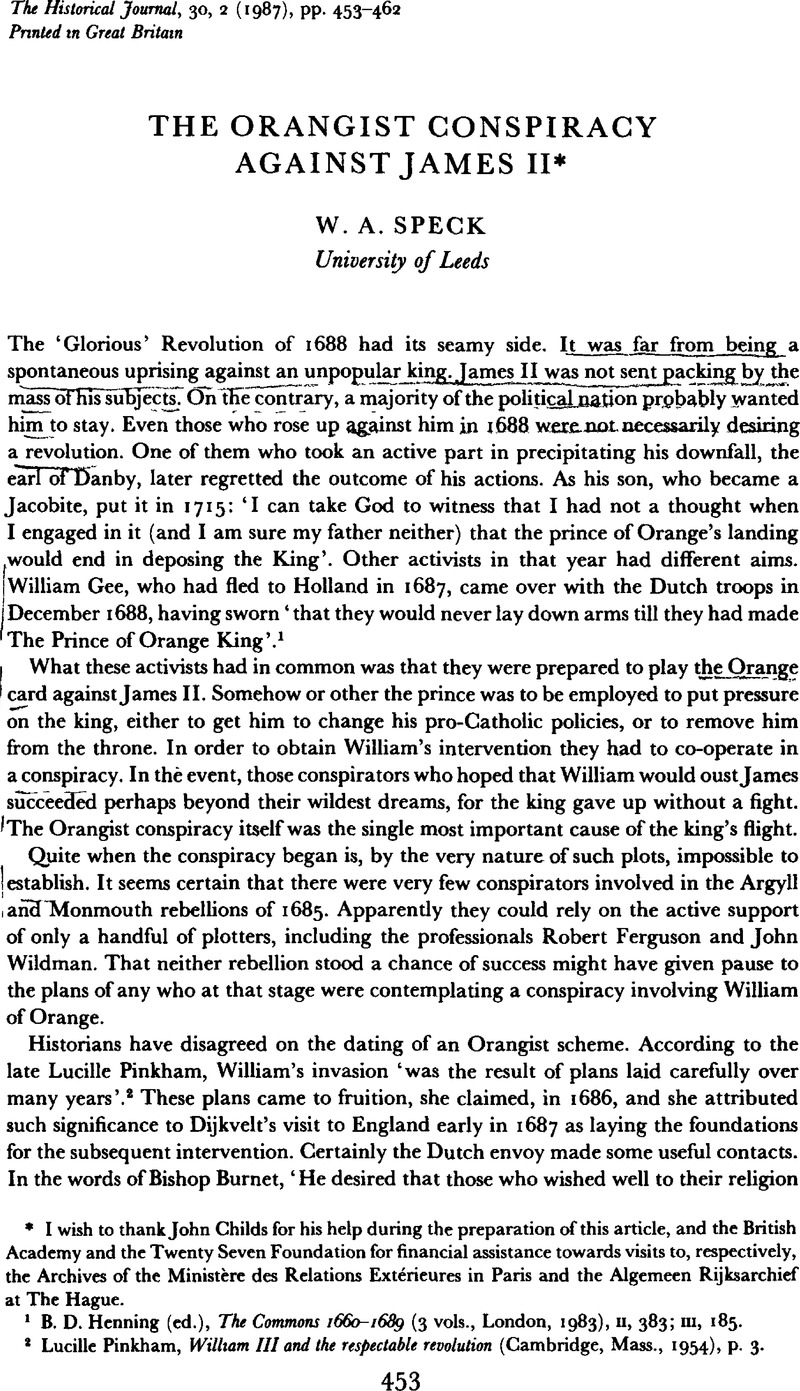Article contents
The Orangist Conspiracy against James II*
Published online by Cambridge University Press: 11 February 2009
Abstract

- Type
- Communications
- Information
- Copyright
- Copyright © Cambridge University Press 1987
References
1 Henning, B. D. (ed.), The Commons 1660–1689 (3 vols., London, 1983), II, 383Google Scholar; III, 185.
2 Pinkham, Lucille, William III and the respectable revolution (Cambridge, Mass., 1954), p. 3CrossRefGoogle Scholar.
3 Burnet, G., History of his own time (6 vols., Oxford, 1833), IV, 180–1Google Scholar.
4 SirDalrymple, John, Memoirs of Great Britain and Ireland (2 vols., London, 1771), II, ii, 191, 197–8Google Scholar.
5 Cumbria Record Office (Kendal), Fleming MS 3168. The French envoy Bonrepos claimed that the replies had been concerted in London. Public Record Office (P.R.O.) 31/3/174; Bonrepos to Seignelay, 4 Dec. 1687.
6 Nottingham University Library, Portland MSS, PWA 2103.
7 Ibid. 2087–178. The contents of these letters, most of which he attributes to Henry Sidney, James Johnstone and James Rivers, are discussed in Jones, J. R., The Revolution of 1688 in England (London, 1972), pp. 225–8Google Scholar.
8 Burnet, , History, IV 240–1Google Scholar.
9 Ibid. p. 277.
10 Ibid. p. 279 note. Horwitz, H., Revolution politicks: the career of Daniel Finch second earl of Nottingham 1647–1730 (Cambridge, 1968), pp. 52–3Google Scholar.
11 Burnet, , History, IV, 279Google Scholar.
12 Childs, J., The Army, James II and the glorious revolution (Manchester, 1980), p. 148Google Scholar.
13 Dalrymple, , Memoirs, II, ii, 239Google Scholar.
14 Bodleian Library, Rawlinson MS, D148, quoted in Childs, , The Army, pp. 161–2Google Scholar.
15 Archives du Ministère des Relations Extérieures, Paris, Correspondence Politique Hollande (hereafter CPH), 155, fos. 199–301. Tellières could have been a Captain Tellier, an officer in the Anglo-Dutch brigade, who supplied Bevii Skelton with sensitive information in 1685. P.R.O., SP84/220, fo. 10. I owe this suggestion and reference to John Childs.
16 CPH, 157, fo. 89.
17 Ibid. fo. 94.
18 CPH, 154, fo. 247.
19 CPH, 155, fo. 15.
20 CPH, 157, fo. 95. The untrustworthy peer was presumably Nottingham.
21 Ibid. fos. 100–112, 115, 135.
22 Ibid. fo. 229; CPH, 155, fos. 316, 342–3. Louis XIV paid for Tellière's widow and three children to return to France where they were converted to Catholicism. CPH, 156, fos. 19–20, 104.
23 Algemeen Rijksarchief, The Hague, Fagel Archive 1: 10: 19: 2019.
24 Ibid. 5/15 June, 9/19 Oct. 1688.
25 Ibid. 13/23 July, 30 Sept./9 Oct. 1688. On 23 Oct./2 Nov. he even wrote that if the prince of Orange did not appear to want the English crown, but spoke only of maintaining the laws and religion of England, all would go well for him.
26 Ibid. 16/26 Oct. 1688.
27 Jones, C., ‘The Protestant wind of 1688: myth and reality,’ European Studies Review, III (1973), 201–21CrossRefGoogle Scholar; Lindgren, S. and Neumann, J., ‘Great historical events that were significantly affected by the weather: 7, “Protestant wind”—“Popish wind”: The Revolution of 1688 in England’, Bulletin of the American Meteorological Society, CVI (1985), 634–44Google Scholar. The presbyterian Roger Morrice noted in his Entering Book for 17 Nov. 1688, ‘The Prince landed neere Exeter by designe from the beginning.’ Morrice MSS, Doctor Williams Library.
28 Japikse, N. (ed.), Correspondentie van Willem III en van Hans Willem Bentinck, (part 1, 2 vols.; part 11, 3 vols.; The Hague, 1927–1935), II, ii, 609–610Google Scholar.
29 Historical Manuscripts Commission, Dartmouth MSS, I, 174: O. Wynne to Dartmouth, 28 Oct. 1688.
30 CPH, 156, fo. 164. d'Avaux derived this information from one of William's valets dechambre, ‘bon Catholique et bon Français’ via a missionary priest at The Hague.
31 Powley, E. B., The English Navy in the Revolution of 1688 (Cambridge, 1928), pp. 67–9Google Scholar.
32 P. LeFevre, ‘Tangier, the Navy and its connection with the Glorious Revolution’, Manners' Mirror (forthcoming). I wish to thank Mr LeFevre for allowing me to use the typescript of his article.
33 Cavelli, Campana de, Les Dermers Stuarts à St Germain (2 vols., London, 1871), II, 266Google Scholar; Hoffmann to the Emperor, I Oct. 1688.
34 HMC Dartmouth, I, 260–1.
35 HMC seventh report, appendix, p. 417.
36 His Majesties reasons for withdrawing himself from Rochester, writ with his own hand and ordered by him to be published, December 22 1688
- 5
- Cited by


